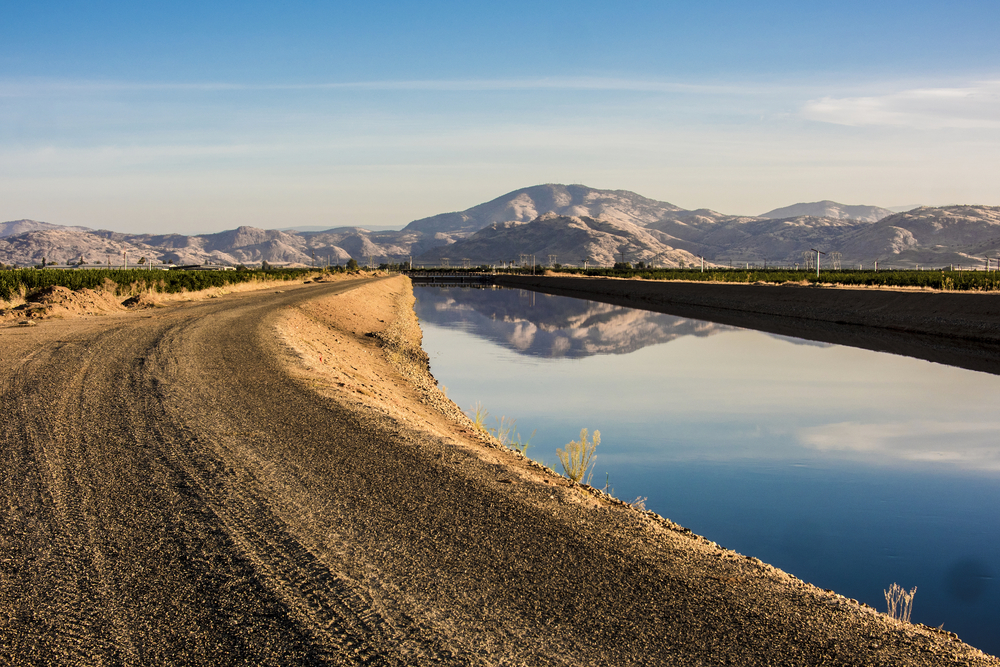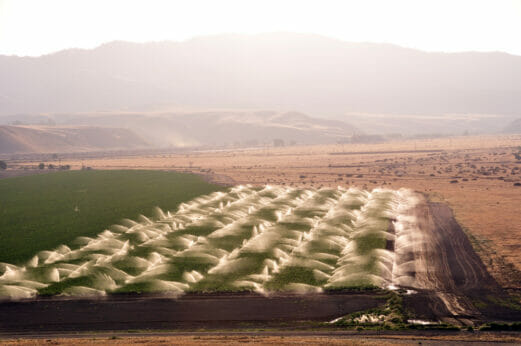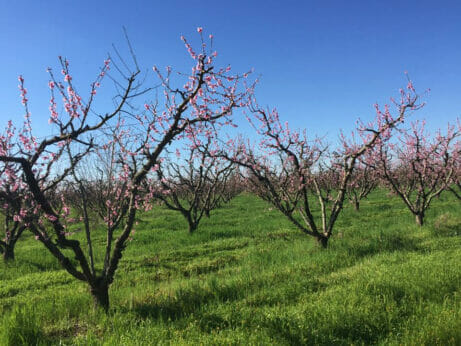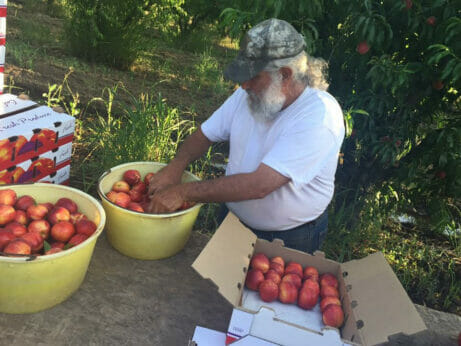Squeezing the Most Out of California’s Water Supply
As agriculture withers amid an ever-warming climate, a flexible approach to water management can help cushion the blow.
Squeezing the Most Out of California’s Water Supply
As agriculture withers amid an ever-warming climate, a flexible approach to water management can help cushion the blow.

The Friant-Kern Canal is part of the San Joaquin Valley's water infrastructure system.by Shutterstock.
On a recent market day at the San Francisco Ferry Building, Tory and Rebecca Torosian of Tory Farms, a second-generation, 80-acre orchard in the San Joaquin Valley, are hawking the last of their navel oranges, lemons and pomegranates as they head into a long hiatus.
Normally, a late winter crop of oro blancos, page mandarins and other citrus carries them into spring, until their nectarines come into season. But for the past two years, the prolonged drought has left their ranch parched; along with slashes to water allocation, the region’s overdrawn water basin has left their wells sputtering.
“We had to prioritize the money makers—our stone fruit and grape vines—and let the other ones dry up,” says Tory. To date, he’s fallowed more than a third of his orchard, much of which the couple planted more than two decades ago. Although the outlook is brighter this year thanks to a historic bout of rain and snow, “replanting those varieties and getting them back to where they were would take five to seven years,” adds Rebecca, “and lots of money and water.”

Most indicators point to a drier future for California, leaving even less water for irrigation. A recent study by the non-profit Public Policy Institute of California (PPIC) shows that by 2040, annual supplies could decline by as much as 20 percent. Yet the research notes that changing climate conditions are only part of the overall calculus. The bigger supply impact comes from the Sustainable Groundwater Management Act (SGMA), a state mandate to limit groundwater pumping to replenish chronically overtapped reserves.
Coupled with dwindling surface supplies and increased environmental regulations, California’s transition to groundwater sustainability could have particularly sobering consequences for the San Joaquin Valley, which is home to nearly 4.5 million irrigated acres and produces $35 billion in agricultural output. Future water constraints could, in the worst case, fallow as much as 900,000 acres of farmland, evaporating close to 50,000 jobs and shaving regional economic activity by 2.3 percent.
Still, a flexible approach to managing supplies can help the region squeeze the most out of a limited supply—all the while working to stabilize the economy and achieve groundwater sustainability.
“Inflexible water management is a costly way to cope with growing water scarcity,” says Alvar Escriva-Bou, a lead researcher on the PPIC study. So local, regional and state cooperation, together with innovative approaches to groundwater recharge and storage, “can really smooth down the impacts.”
An agricultural triage
Enacted in 2014, the SGMA sets a localized framework for managing groundwater extraction, with the long-term goal of restoring depleted basins. In its initial 2019 assessment, the PPIC predicted that the impact on the valley’s water supply could fallow up to 500,000 acres of farmland. “Back then, we didn’t have the data we have today,” says Escriva-Bou, who co-authored the original report, explaining the near-twofold increase reflected in the recent update. “We were looking at big numbers at the basin scale, and we didn’t know where the overdraft was happening.”
Since then, the establishment of Groundwater Sustainability Agencies (GSA)—public entities empowered with managing groundwater within a district—has revealed a more precise tally of local conditions, including “white areas” isolated from surface water deliveries and reliant solely on wells.

The latest report also accounts for new factors that have surfaced. Updated climate models, for instance, forecast less precipitation and increased crop water demands. And a recent state proposal to release larger stored volumes into the Sacramento-San Joaquin Delta—an environmental measure intended to boost flows to protect endangered fish species—is expected to further tax state reservoirs.
While the combined impacts could dry up as much as 20 percent of the valley’s agricultural water needs, increasing and optimizing supplies can go a long way in cushioning the blow.
One of the most affordable approaches—and seemingly obvious this past winter—is banking excess rain. “California still has cycles of wet years, when there’s a lot of water that we can’t capture in reservoirs,” says Escriva-Bou. And to minimize flood risk, the state keeps storage capacity partly empty during the winter in anticipation of storms. Rather than flushing those flows out into the Pacific, some of the volume can be banked underground.
Managed Aquifer Recharge (MAR) uses dedicated recharge basins in areas with sandy soil to percolate water into aquifers. “It’s one of the cheapest supply options,” says Escriva-Bou, “because in many cases, we already have the infrastructure.” Although large-scale efforts require building levees, flooding farmland during the wet off-season can be just as effective—“though you have to convince farmers that it’s not a problem for their crops or tree roots, as it’s not a traditional farming practice,” he says. And because the endeavor involves some outlay in labor and expense by growers for the benefit of the larger basin, it’ll take financial incentives to persuade the masses, he notes.
The most effective strategy to reduce impacts, however, is maximizing the available supply and working cooperatively within the vast, eight-county valley to leverage its wide range of conditions.
Individual basins can have large internal differences in water availability: Some areas receive no surface water and grow profitable crops such as fruits and nuts, while those in nearby irrigation districts may have more latitude to grow thirstier but less profitable crops such as alfalfa. In a triage of sorts, trading reallocates groundwater to locales where cutbacks would be most costly, to minimize economic impact.
And “because [you’re drawing from] the same aquifer, you don’t need additional infrastructure,” says Escriva-Bou. With agricultural wells now required to be metered, the process becomes a matter of accounting.
Along with intra-basin trading, implementing a valley-wide surface water exchange would magnify that flexibility, redirecting supplies from the region’s rainier, northern reaches to drier and highly overdrafted districts to the south and east. The report estimates that, together, the two trading scenarios could shrivel forecasted GDP losses by as much as half and job losses by up to 44 percent.
Yet without trading, overdrafted basins would face water cutbacks for all crops. Perennials, which cover 61 percent of the valley, would be hit especially hard, with orchard farms and vineyards left even more vulnerable. “There’s a huge difference between growing alfalfa and trees or vines, because [the latter] are 12- to 25-year investments,” says Tory Torosian, the fruit farmer. “If you’ve spent all that money to get an orchard in and suddenly there’s not enough water, you’re really up [a] creek.”

The haves and the have-nots
Although water trading can be construed as commodifying a resource, “in this context, it’s a tool for reallocation,” says Escriva-Bou. Access to water divides the agricultural industry into the haves and the have-nots, he adds. “So without any trading, you’re condemning the have-nots to [further] socioeconomic losses.” In other words, trading can rebalance the supply to benefit entire basins and the valley as a whole.
While seemingly straightforward, the proposition requires navigating uncharted territory to develop new regulations. Although surface trading is an existing practice, strict measures and infrastructure limitations often relegate it to tightly prescribed boundaries, largely within a county or irrigation district. And currently, most places in California ban groundwater trading altogether, says Escriva-Bou, although a few districts have started to develop plans. It’s a complex endeavor that requires controls to prevent impacts, he adds. Too much pumping in a given location, for instance, can cause subsidence or tax shallower domestic wells.
Ultimately, small-scale farmers like Torosian hope for straightforward solutions that won’t require a dedicated compliance team. “I think all of us understand that SGMA is just common sense,” he says. “I just hope we’re not going to lose all the little guys in the process.”

Escriva-Bou emphasizes that SGMA’s goal is to equalize allocations for all growers. In the past, “it was easier for big farms to keep digging deeper wells,” he says. “SGMA puts a stop to these unsustainable practices and helps stabilize groundwater decline.”
“California agriculture will still thrive if we actually take the right steps and actions,” says Escriva-Bou. Innovation and flexibility are hallmarks of the trade, he adds, noting that the state has seen steady increases in yield for almost every crop for the past 40 years—a trend he expects to continue, even with less water and acreage.
“Ten years ago, nobody even wanted to talk about groundwater regulations,” says Escriva-Bou, “but now, we have an actual plan to face that reality. So, I’m optimistic.”
Follow us
This work is licensed under a Creative Commons Attribution-NoDerivatives 4.0 International License.
Want to republish a Modern Farmer story?
We are happy for Modern Farmer stories to be shared, and encourage you to republish our articles for your audience. When doing so, we ask that you follow these guidelines:
Please credit us and our writers
For the author byline, please use “Author Name, Modern Farmer.” At the top of our stories, if on the web, please include this text and link: “This story was originally published by Modern Farmer.”
Please make sure to include a link back to either our home page or the article URL.
At the bottom of the story, please include the following text:
“Modern Farmer is a nonprofit initiative dedicated to raising awareness and catalyzing action at the intersection of food, agriculture, and society. Read more at <link>Modern Farmer</link>.”
Use our widget
We’d like to be able to track our stories, so we ask that if you republish our content, you do so using our widget (located on the left hand side of the article). The HTML code has a built-in tracker that tells us the data and domain where the story was published, as well as view counts.
Check the image requirements
It’s your responsibility to confirm you're licensed to republish images in our articles. Some images, such as those from commercial providers, don't allow their images to be republished without permission or payment. Copyright terms are generally listed in the image caption and attribution. You are welcome to omit our images or substitute with your own. Charts and interactive graphics follow the same rules.
Don’t change too much. Or, ask us first.
Articles must be republished in their entirety. It’s okay to change references to time (“today” to “yesterday”) or location (“Iowa City, IA” to “here”). But please keep everything else the same.
If you feel strongly that a more material edit needs to be made, get in touch with us at [email protected]. We’re happy to discuss it with the original author, but we must have prior approval for changes before publication.
Special cases
Extracts. You may run the first few lines or paragraphs of the article and then say: “Read the full article at Modern Farmer” with a link back to the original article.
Quotes. You may quote authors provided you include a link back to the article URL.
Translations. These require writer approval. To inquire about translation of a Modern Farmer article, contact us at [email protected]
Signed consent / copyright release forms. These are not required, provided you are following these guidelines.
Print. Articles can be republished in print under these same rules, with the exception that you do not need to include the links.
Tag us
When sharing the story on social media, please tag us using the following: - Twitter (@ModFarm) - Facebook (@ModernFarmerMedia) - Instagram (@modfarm)
Use our content respectfully
Modern Farmer is a nonprofit and as such we share our content for free and in good faith in order to reach new audiences. Respectfully,
No selling ads against our stories. It’s okay to put our stories on pages with ads.
Don’t republish our material wholesale, or automatically; you need to select stories to be republished individually.
You have no rights to sell, license, syndicate, or otherwise represent yourself as the authorized owner of our material to any third parties. This means that you cannot actively publish or submit our work for syndication to third party platforms or apps like Apple News or Google News. We understand that publishers cannot fully control when certain third parties automatically summarize or crawl content from publishers’ own sites.
Keep in touch
We want to hear from you if you love Modern Farmer content, have a collaboration idea, or anything else to share. As a nonprofit outlet, we work in service of our community and are always open to comments, feedback, and ideas. Contact us at [email protected].by Naoki Nitta, Modern Farmer
March 21, 2023
Modern Farmer Weekly
Solutions Hub
Innovations, ideas and inspiration. Actionable solutions for a resilient food system.
ExploreExplore other topics
Share With Us
We want to hear from Modern Farmer readers who have thoughtful commentary, actionable solutions, or helpful ideas to share.
SubmitNecessary cookies are absolutely essential for the website to function properly. This category only includes cookies that ensures basic functionalities and security features of the website. These cookies do not store any personal information.
Any cookies that may not be particularly necessary for the website to function and are used specifically to collect user personal data via analytics, ads, other embedded contents are termed as non-necessary cookies.
Not a mention of plastic!!!
CA also doesn’t have all the needed reservoirs. Money’s been voted to fund them but “environmentalists” keep throwing obstacles in the way. We lost a LOT of water from this past rainy season, just went into the ocean. Should never have happened.
Kind of difficult to write an article like this without using the word, “almonds”.
Experiences in Syntropic agriculture have shown that plants can ‘drink’ water directly from the humidity in the atmosphere, even in times of drought. Hydroscopic mycorrhizal fungi have the ability to condense and conduct moisture to the plant’s root zone, on demand, directly from humidity in the air. Even in deserts there is some percent of humidity in the air, especially at night. But only plants in the vigorous part of their growth curve have hydroscopic fungal partners, once the plant begins to mature or show signs of senecence it’ll change its fungal associate to a hydrophobic species, drying the soil… Read more »